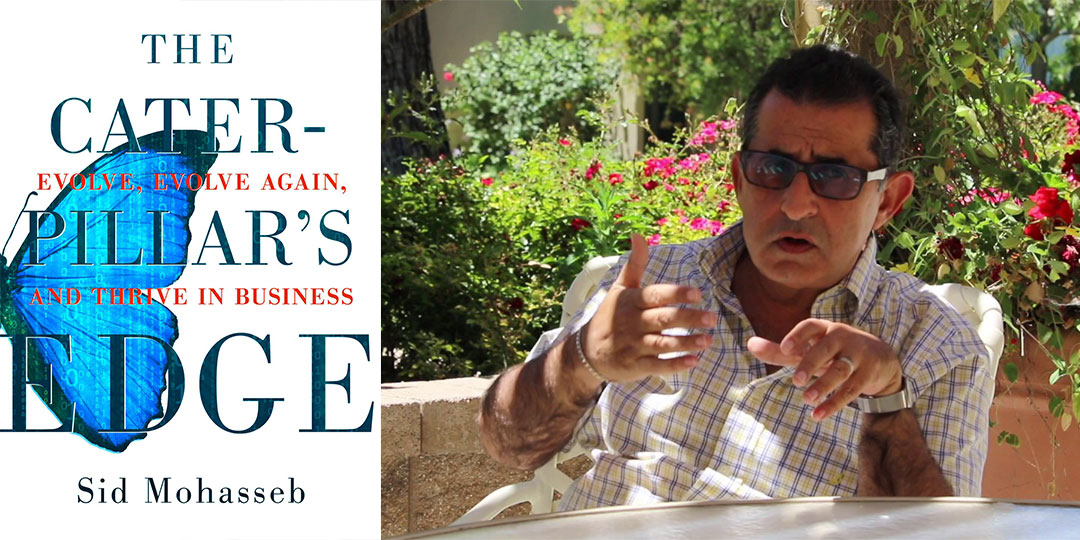The Caterpillar’s Edge is a book about embracing change to gain a competitive edge and flourish in today’s global business climate. Its author, Sid Mohasseb, is an adjunct professor, a venture capitalist, a corporate CEO, the former strategic innovation lead in strategy for a conglomerate, a Harvard-trained negotiator, and a featured TED Talk speaker. Sid’s notable expertise is in connecting theory and reality to help people see the curves in the road ahead and to realize their visions for the future.
I had an opportunity to sit down with Sid to understand his view on innovation.
How did you come up with premise for The Caterpillar’s Edge?
While every industry is going through significant change and facing considerable innovation and challenges, we plan and strategies in the same manner we did decades ago: we follow a structured budgeting process and yearlong planning cycles. We create innovation labs to methodically look to the future and get our smart strategy team to create scenarios and then expect certainty in execution. We are addicted to how things worked in the past.
I’ve seen firsthand our dependence on processes and lack of appreciation of the fundamental change we are facing from various perspectives. I’ve sat on a number of boards, been a CEO many times over, been a consultant to the Fortune 100s, and worked with early stage companies. And through it all, I’ve sees the same thing over and over: addiction to the past, influenced by our orthodoxies and jaded thoughts. The competitive world we live in now is a reality show where endings cannot be predicted. We have to erase the arbitrary lines between planning and execution, and be ready to pivot and change at any time. We should not be looking just to manage change but to fully embrace it. Hell, we should champion change because it’s now riskier to seek stability than transformation. We should seek to stay relevant at all times, and given the rapid rate of innovation and flux in customer expectations that means being ready to evolve at all times. The caterpillar manages over 4,000 muscles (you and I have barely over 600) and goes through multiple stages of metamorphosis before it changes from one form into another—one that can fly. In going through that process, it doesn’t require a yearlong change management program. For the caterpillar, metamorphosis is a complex system that emerges, evolves, and manages change as it’s occurring. It’s this ability to evolve in increments—purposefully and in a connected and coordinated manner—that I call the caterpillar’s edge, a competitive edge that will allow organizations to not leave change to chance!

Author Sid Mohasseb at a recent launch event for his book, The Caterpillar’s Edge
Addiction is a pretty strong word. Could you explain it in this context?
Here’s an example of what I mean by addiction. Why isn’t Twitter making money? Jack Dorsey has been back in charge for a while and he is a smart guy. He has also assembled other smart guys like Omid Kordestani, the legendary former Google guru and rain maker. But they’re trying to apply the same formula that made them successful in the past to entirely new situations, with a different set of competitors who are capturing people’s imagination differently and are meeting a significantly higher level of customer expectations. They’re now competing in a hyper-innovative environment, one that’s incomparable to that of a decade or so ago when these men started to make their marks. And so after a great deal of pontification, the end result was to go from 140-character tweets to 280. Come on! Tinkering with a product is neither evolution nor strategy, and it’s certainly not innovation! Their leadership is not stupid; it’s just comfortable with sameness and afraid of change.
To win in this ultra-competitive, ultra-fast, ultra-connected world, we have to shift our mind and actions and realize that all advantages are temporary. To stay relevant we must always evolve. The first step in that direction is for people to shed their addictions to what they know or think they know. A couple of the suggestions I offer in The Caterpillar’s Edge are:
- Try to disprove yourself and your ideas—use data! Change your frame of refence. If you cannot with objectivity disprove those ideas, then you’re acting out of intelligence. If you can, then you were acting out of habit. Look at both sides of the discussion.
- Provide an opportunity to others to disprove themselves too, without the fear of being labeled as failures.
- Be purposefully curious at all the time. Use curiosity to shorten the time between strategy and execution.
- Stop failing fast and focus on learning fast. Learn from others, from data, from experiences and experiments. Then execute on the new learning fast; innovate faster and pivot to a new focus intelligently and before it’s too late.
How do you define innovation?
If you look at known facts and adjust things in response to them, then what you’re doing is improving—which of course is a very important factor in truly leveraging and sustaining a competitive advantage. Let’s call that process improvement. Innovation, on the other hand, is where you try to explore the unknown—what was previously ignored by others—and derive new value from it. That could be new value delivered to the customer (such as from the Motorola flip phone to the iPhone or from the iPod to Spotify) or a new way of manufacturing (such as going from enhancing a car every 3 to 5 years with a new platform and model to formulating ways to enhance a car while sitting in the garage overnight—think Tesla). Henry Ford famously stated, “If I had asked people what they wanted, they would have said faster horses.” In other words, people weren’t thinking of a car. Innovation is creating new value from new things and not just improving existing products.
Do you feel most CEOs know how to innovate?
In my book, I speak about business addiction—falling back on what we know—and the need to re-examine how we play the game and win, not only once but over and over again. A professional basketball player knows the rules of basketball, the offensive and defensive moves, the 24-second rule and zone plays. Now take the same player, a great athlete, and have him or her play cricket. He or she may be smart and fit, but the rules have changed. The strategies to win are different and execution and position placement are different. The CEOs are good at what they do, they are mostly smart and dedicated. However, the rules of engagement in this competitive world of constant innovation and change are now different. Innovating to constantly find new value and value propositions is much more than re-labeling our R&D departments and calling them Innovation Labs. Innovation is messy, filled with uncertainty, and cannot be separated from execution. Innovation is about finding new value in everything we do all the time. CEOs today inherently know how to innovate. But they’re trying to reduce risk and superimpose the rules of the old games, which they’re really good at, to an extremely fast and unforgiving game with entirely new rules.
Can you discuss how CEOs perceive the importance of innovation?
To be blunt, lots of CEOs like to talk about “innovation” and the initiatives around it because the market likes it. If investors or Wall Street is interested in innovation, then CEOs are interested. Companies that have innovation labs are perceived differently by the marketplace—that’s a fact.
Now, don’t get me wrong, CEOs love to leave a legacy of greatness and love to be known for being innovative and leading change. However, failure is still rather toxic in most originations. Stability and steadiness is rewarded. CEOs absolutely realize the importance of innovation both to them personally and to the success of the organization. But they also realize that there are consequences to being bold and breaking things in order to evolve. So, they mostly choose to be methodical and aim to achieve certainty in a world that is more and more uncertain.


